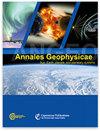Observations of traveling ionospheric disturbances driven by gravity waves from sources in the upper and lower atmosphere
IF 1.9
4区 地球科学
Q3 ASTRONOMY & ASTROPHYSICS
引用次数: 0
Abstract
Abstract. Traveling ionospheric disturbances (TIDs) are observed by the Super Dual Auroral Radar Network (SuperDARN), the Poker Flat Incoherent Scatter Radar (PFISR), the multipoint and multifrequency continuous Doppler sounders, and the GNSS total electron content (TEC) mapping technique. PFISR measures electron density altitude profiles, from which TIDs are obtained by a filtering method to remove background densities. SuperDARN observes the ionospheric convection at high latitudes and TIDs modulating the ground scatter power. The Doppler sounders at mid latitudes can determine TID propagation velocities and azimuths. The aim of this study is to attribute the observed TIDs to atmospheric gravity waves generated in the lower thermosphere at high latitudes, or gravity waves generated by mid-latitude tropospheric weather systems. The solar wind-magnetosphere-ionosphere-thermosphere coupling modulates the dayside ionospheric convection and currents that generate gravity waves driving equatorward propagating medium to large scale TIDs. The horizontal equivalent ionospheric currents are estimated from the ground-based magnetometer data using an inversion technique. At high latitudes, TIDs observed in the detrended TEC maps are dominated by equatorward TIDs pointing to auroral sources. At mid to low latitudes, the azimuths of TIDs vary, indicating sources in the troposphere. The cases of eastward to southeastward propagating TIDs that are observed in the detrended TEC maps and by the HF Doppler sounders in Czechia are attributed to gravity waves that were likely generated by geostrophic adjustment processes and shear instability in the intensifying low-pressure systems.观测由来自大气层上层和下层的重力波驱动的电离层巡回扰动
摘要。通过超级双极光雷达网、扑克牌平相干散射雷达、多点和多频连续多普勒探空仪以及全球导航卫星系统电子总含量(TEC)绘图技术观测电离层旅行扰动。PFISR 测量电子密度高度剖面,通过滤波方法去除背景密度,从中获得 TID。SuperDARN 观测高纬度电离层对流和调制地面散射功率的 TID。中纬度的多普勒探测仪可以确定 TID 的传播速度和方位角。本研究的目的是将观测到的 TID 归因于高纬度低热层产生的大气重力波或中纬度对流层天气系统产生的重力波。太阳风-磁层-电离层-热大气层耦合调节日侧电离层对流和电流,产生重力波,推动赤道向外传播中尺度到大尺度的热电离层波动。水平等效电离层电流是利用反演技术从地基磁强计数据中估算出来的。在高纬度地区,在去趋势 TEC 图中观测到的 TID 主要是指向极光源的赤道向 TID。在中低纬度,TID 的方位角各不相同,表明其来源于对流层。捷克的高频多普勒探空仪和经过去趋势处理的 TEC 地图中观测到的向东向东南传播的 TID,是由重力波引起的,而重力波很可能是由地心调整过程和不断加强的低压系统中的切变不稳定性产生的。
本文章由计算机程序翻译,如有差异,请以英文原文为准。
求助全文
约1分钟内获得全文
求助全文
来源期刊

Annales Geophysicae
地学-地球科学综合
CiteScore
4.30
自引率
0.00%
发文量
42
审稿时长
2 months
期刊介绍:
Annales Geophysicae (ANGEO) is a not-for-profit international multi- and inter-disciplinary scientific open-access journal in the field of solar–terrestrial and planetary sciences. ANGEO publishes original articles and short communications (letters) on research of the Sun–Earth system, including the science of space weather, solar–terrestrial plasma physics, the Earth''s ionosphere and atmosphere, the magnetosphere, and the study of planets and planetary systems, the interaction between the different spheres of a planet, and the interaction across the planetary system. Topics range from space weathering, planetary magnetic field, and planetary interior and surface dynamics to the formation and evolution of planetary systems.
 求助内容:
求助内容: 应助结果提醒方式:
应助结果提醒方式:


